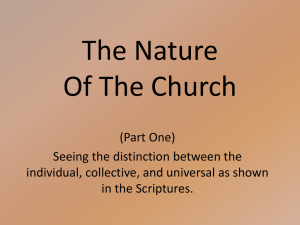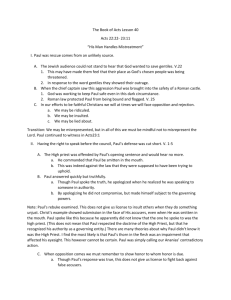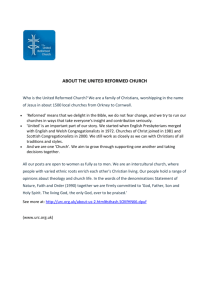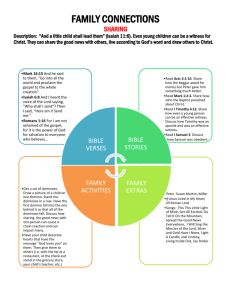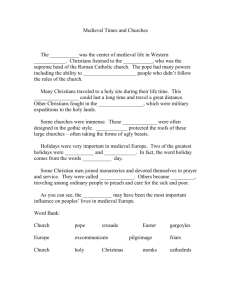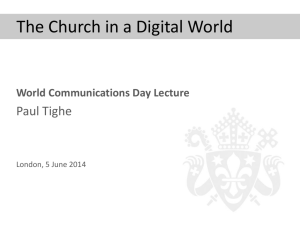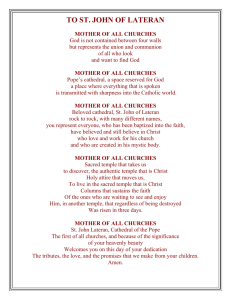The Bose Monastery's Ecumenical Martyrology
advertisement
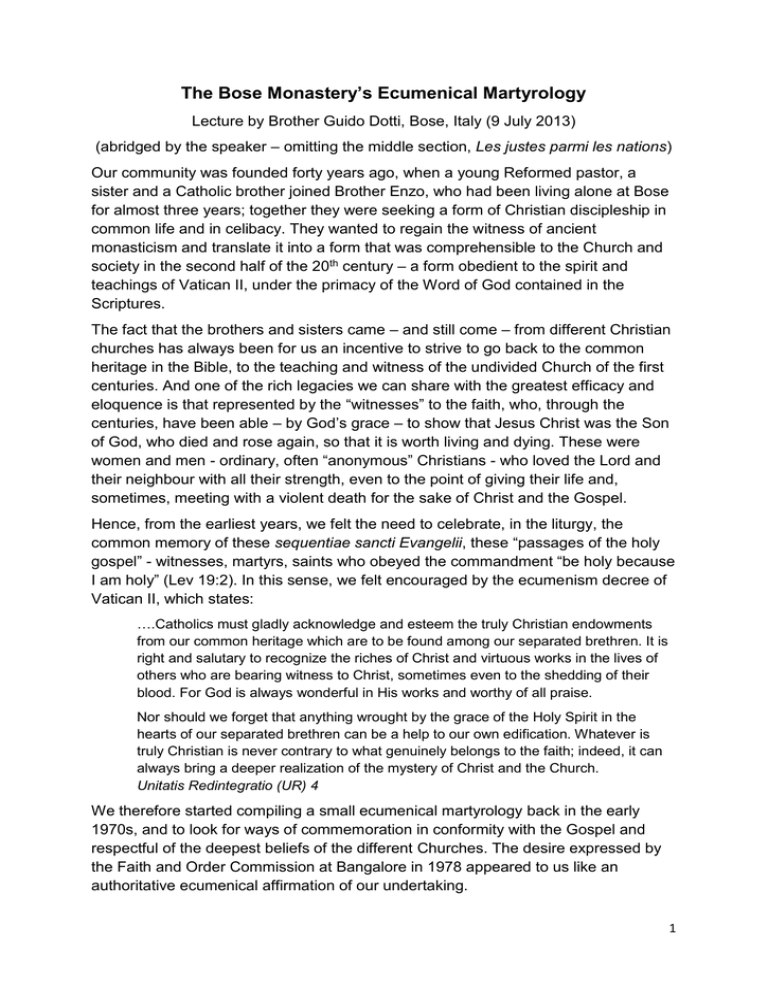
The Bose Monastery’s Ecumenical Martyrology Lecture by Brother Guido Dotti, Bose, Italy (9 July 2013) (abridged by the speaker – omitting the middle section, Les justes parmi les nations) Our community was founded forty years ago, when a young Reformed pastor, a sister and a Catholic brother joined Brother Enzo, who had been living alone at Bose for almost three years; together they were seeking a form of Christian discipleship in common life and in celibacy. They wanted to regain the witness of ancient monasticism and translate it into a form that was comprehensible to the Church and society in the second half of the 20th century – a form obedient to the spirit and teachings of Vatican II, under the primacy of the Word of God contained in the Scriptures. The fact that the brothers and sisters came – and still come – from different Christian churches has always been for us an incentive to strive to go back to the common heritage in the Bible, to the teaching and witness of the undivided Church of the first centuries. And one of the rich legacies we can share with the greatest efficacy and eloquence is that represented by the “witnesses” to the faith, who, through the centuries, have been able – by God’s grace – to show that Jesus Christ was the Son of God, who died and rose again, so that it is worth living and dying. These were women and men - ordinary, often “anonymous” Christians - who loved the Lord and their neighbour with all their strength, even to the point of giving their life and, sometimes, meeting with a violent death for the sake of Christ and the Gospel. Hence, from the earliest years, we felt the need to celebrate, in the liturgy, the common memory of these sequentiae sancti Evangelii, these “passages of the holy gospel” - witnesses, martyrs, saints who obeyed the commandment “be holy because I am holy” (Lev 19:2). In this sense, we felt encouraged by the ecumenism decree of Vatican II, which states: ….Catholics must gladly acknowledge and esteem the truly Christian endowments from our common heritage which are to be found among our separated brethren. It is right and salutary to recognize the riches of Christ and virtuous works in the lives of others who are bearing witness to Christ, sometimes even to the shedding of their blood. For God is always wonderful in His works and worthy of all praise. Nor should we forget that anything wrought by the grace of the Holy Spirit in the hearts of our separated brethren can be a help to our own edification. Whatever is truly Christian is never contrary to what genuinely belongs to the faith; indeed, it can always bring a deeper realization of the mystery of Christ and the Church. Unitatis Redintegratio (UR) 4 We therefore started compiling a small ecumenical martyrology back in the early 1970s, and to look for ways of commemoration in conformity with the Gospel and respectful of the deepest beliefs of the different Churches. The desire expressed by the Faith and Order Commission at Bangalore in 1978 appeared to us like an authoritative ecumenical affirmation of our undertaking. 1 It is desirable to publish an ecumenical anthology of reports of martyrdom, both in earlier times and in our day, for use in all Churches, since the witness of martyrs goes well beyond confessional boundaries and leads us to the centre of the faith, the source of hope and the example of love for God and fellow human beings. The use of this book would strengthen solidarity of Christians, in prayer and action, with those in difficult and dangerous situations. Sharing in one hope, report of the Faith and Order Commission, Bangalore 1978. When, in only a few months, from November 1994 to May 1995, two texts by Pope John Paul II – the apostolic letter Tertio millennio adveniente, then the encyclical Ut unum sint – highlighted this subject, we felt emboldened to produce a volume containing the results of our search. The pope stated: At the end of the second millennium, the church has again become a church of martyrs…The witness to Christ borne even to the shedding of blood has become a common inheritance of Catholics, Orthodox, Anglicans and Protestants…This witness must not be forgotten … Perhaps the most convincing form of ecumenism is the ecumenism of the saints and of the martyrs. Tertio millennio adveniente (TMA) 37 In a theocentric vision, we Christians already have a common Martyrology. … I have already remarked, and with deep joy, how an imperfect but real communion is preserved and is growing at many levels of ecclesial life. I now add that this communion is already perfect in what we all consider the highest point of the life of grace, martyria unto death, the truest communion possible with Christ who shed his Blood, and by that sacrifice brings near those who once were far off (cf. Eph 2:13). While for all Christian communities the martyrs are the proof of the power of grace, they are not the only ones to bear witness to that power. Albeit in an invisible way, the communion between our Communities, even if still incomplete, is truly and solidly grounded in the full communion of the Saints—those who, at the end of a life faithful to grace, are in communion with Christ in glory. These Saints come from all the Churches and Ecclesial Communities which gave them entrance into the communion of salvation. Ut Unum Sint (UUS) 84 The Confessio Helvetica, in turn, recognizes the importance of remembering the saints in the Church’s preaching. It is interesting that, at Bangalore, where the representatives of the Churches of the Reformation were present in great numbers, they had the courage to affirm (in the document Witness unto Death: Martyrdom as Ultimate Hope) that the Church recognizes Christ in person in the martyrs, the very heart of its faith, beyond any kind of interpretations and divisions. The very foundation of a memory, even liturgical, of the saints and their imitation of Christ revives our faith in him and makes us accede to the communion sanctorum of the Church. So for several contemporary authors in the Reformation tradition it is possible, on certain conditions, to introduce the memory of saints into the public prayer of the church community. One can give thanks to God for the saints; and, paradoxically, it may even be more dangerous to remove that memory than to find the right position for it in church liturgy. 2 In the wake of this reflection, Bose’s ecumenical liturgy has from the beginning provided for a commemoration of the saints enhanced with appropriate Bible readings “situating” them in God’s plan as found in Scripture; there is also a prayer of praise or intercession to God the Father, a prayer that emphasizes the main points about each witness, asking God to give similar gifts to the congregation by the sole mediation of Christ the Lord. The Church of England went the same way from 1997, courageously launching a new calendar with prayers and Bible readings for each of the memories. Different Lutheran churches are following a similar course. For this reason we have, wherever possible, used the prayers and Bible readings drawn from the Bose Office or the Anglican Sanctoral. We have not hesitated to take prayers in other styles, particularly from the eastern Churches or, in part, from the western tradition. Each church has its own way of remembering the saints in prayer; the fact of getting to know their own sensitivity directly through the texts of their prayers is fully in the spirit of a martyrology seeking to be ecumenical, and striving to be honest and open about differences instead of glossing over them. Moreover, wherever there is no firm, proven custom of celebrating witnesses in the liturgy, we have preferred not to use prayers and Bible readings at all. No “canonization” The readers of our Book of Witnesses will rapidly see that the persons we have chosen also include those who have not been officially recognized as saintly by their respective Churches. In daring to do so, we never intended to canonize anyone: we have no authority to do so and are well aware of that. However, we also know that canonization, of which the history is complex and diverse depending on the different church traditions, is only the last phase, at least in Catholic and Orthodox tradition. Here the supreme authority of the Church not only recognizes a faithful witness of the Gospel of Christ, but also encourages us to promote his/her memory. A day will come, perhaps, when we will have recovered full communion in the Church and between the Churches, when a number of these person that we present perhaps all - will find their place in the official lists of the undivided Church. For the present we give thanks to God for the rays of his light that reach us through them, aware that in the heavenly Jerusalem, the true lamp is the lamb (Rev 21:23). Defining a Christian “martyr” The basic theological problem we had to face was that of criteria: how to choose the witnesses to mention day after day. The first question was: who is a martyr (Greek: martys), a Christian “witness”? From the first centuries there were official attempts to enlarge the classical concept of martyr, first solely reserved for all those who had shed their blood and were persecuted in odium fidei. Undoubtedly, few would now deny the title of martyr to those who, because of their faith, defended the poor unto death and those who are persecuted by the potentates of this world. 3 Nevertheless, there is another important fact, i.e. that the martyrologies of the whole world were quick to start numbering confessors, bishops, monks and then other categories of Christian among the witnesses “until the end”. What counts is that a man or a woman testifies to great faithfulness to the Gospel through the whole span of their life. It was by deepening this idea of faithful witness, even to conformity with Christ, the only totally faithful witness, that we were able to define as “martyrwitnesses” those who, throughout their whole life, caused their brothers and sisters to live. What makes a person a martyr, a true witness to Christ, is their conformity to the Lord: only those who live in the footsteps of the Lord Jesus, renouncing their own life day after day so that others may live, witness to a certain extent to the power of the resurrection already operating in this world; they offer a credible response to the thirst for meaning that has constantly held human beings in its grip. So while our Book of Witnesses focuses primarily on martyrs in the strict sense, we were unable to ignore the memory of the saints of all the Churches that have, in different ways, but no less profoundly, borne witness to the unique message of the Gospel, and borne visible fruits of the free and powerful action of God’s Spirit. The Righteous and the Martyrs of Israel The Jewish scriptures several times mention as models for the righteous of Israel those who obey the commandments of the Torah in all their lives. Walking in the law of the Lord, Psalm 1 recalls, is being “like trees planted by streams of water, which yield their fruit in its season,” for the individual and for others. The Christian Churches soon understood the need to remember - besides the martyrs and Christian confessors, bishops and monks – the righteous of the Old Testament, and a number of them continue to include at least the great prophets in their calendars. But the First Covenant has not been revoked (Rom 9:6ff): Israel has lasted through history, as many Christians have finally recognized after centuries of a theology of the “substitution” of Israel by the Church. So we did not think it possible to recall in a sufficiently comprehensive manner the saving economy of God accomplished in Jesus Christ without including in our Book of Witnesses several sons of Israel who lived in full compliance with the Torah, even after the coming of the One whom Christians recognized as the Messiah of Israel and the Light of the Nations. Therefore, besides the great figures of the Old Testament, it is possible to recall these sons of Israel who, over the centuries, have “sanctified the name” of YHWH, by shedding their blood or giving their life to remain faithful to the Covenant. But aware of the subtle difficulty of such an enterprise – when it is conducted by Christians – we merely inquired from the Jews themselves, being inspired by their calendars and their martyrologies, and asking advice from friends of the Jewish communities with which we have lived in mutual esteem and respect for years. In addition, the structure of a “menology” [monthly calendar] for the days when we remember a Jewish witness is without prayers. Silence provides the space necessary to cope with the temptation 4 that Christians sometimes have to appropriate what does not belong to them, in the name of a poorly understood “catholicity” of their faith. The Jews killed at the hand of Christians The memory of the martyrs of Israel leads inexorably to a crucial aspect of our martyrology. Remembering the martyrs, in fact, is one of the essential components of building the Church. But it is also necessary to remember what the Christians themselves contributed by way of contradictions to the Gospel, sometimes in a very painful way, during the history of the Church. It is no accident that, before inviting the faithful to celebrate the memory of the martyrs common to all the Churches, John Paul II wanted to include in Tertio Millennio adveniente two big paragraphs inviting Christians to profoundly examine their conscience and ask forgiveness for their unfaithfulness to the Lord down the centuries. And John Paul II set the example here. Let us remember the Liturgy of forgiveness celebrated at St Peter’s, on 12 March 2000, at the beginning of Lent. It is no accident that it preceded by two months the ecumenical commemoration of the witnesses of all the Churches celebrated in the Coliseum on 7 May, in the middle of the Easter season. For this reason we wanted to include the memory of the Jews who died at the hand of Christians or with their complicity, in all latitudes and all ages, because they thought in all conscience that they had to remain faithful to the God who had revealed himself to them in the Torah. Evoking their memory seems to us a serious way, perhaps the only one, to carry out that examination of conscience without which it is certainly not possible for any of us to experience a true conversion and a renewed fidelity to the Gospel. Christians who died at the hand of Christians Due to the definition we have given of Christian martyrs and witnesses, it is clear that one can never play one martyr off against another one. A martyr will teach us to pray for his/her enemies, as did the first Christian martyr, Stephen, in order to cover them with the infinite mercy that comes from the Lord. We should not make the celebration of martyrs, even “ecumenical” ones, the occasion to reawaken new hatred and new divisions. Paul VI reminded us of that when he very carefully explained the significance of the beatification of forty Catholic martyrs in England and Wales, in 1970. The best means of removing such a risk is not simply forgetting them. It would be easy to act as though we knew nothing of the thousands of Christians who died, down the ages, at the hand of Christians from other churches who could not tolerate their difference. For that reason we wanted to include the memory of those whom Eberhard Bethge, the biographer and friend of Dietrich Bonhoeffer, called “confessional martyrs” – those Christians killed by other Christians in the name of a truth which, certainly, could not be the truth revealed in Christ Jesus. 5 We must have the courage to recall the Protestants slaughtered by Catholics in the “Massacre of St Bartholomew”, just as we must mention the Orthodox Serbs massacred by the Ustashi (Croation revolutionary movement) because they did not want to convert to Catholicism. Or again those Catholics of the oriental rite persecuted, tortured and put to death because they did not agree to join Orthodoxy, the only confession tolerated in the totalitarian countries of Eastern Europe. We also need to remember all those Catholics victim of repression in the states where the official religion was Protestantism, or those called the “old believers”, put to death by the thousand in Orthodox Russia. Let us add the Nestorians and Monophysites persecuted by the “Great Church”. And the examples could, alas, continue. Moreover, the Church can certainly not forget all the heretics or presumed heretics persecuted by the inquisitions of all the ages and delivered to the “secular arm”; remembering the victims of church tribunals does not mean that we raise up as models of Christian life those who deviated from the apostolic faith, but it is important to ask radical questions about the idea of truth that led Christians to exercise such forms of coercion on consciences, and to practise such physical and moral violence. Among such a large number – certainly too large – of victims of different forms of capital punishment at the order of Churches, we wanted to remember those figures that the authorities of those same church communities have since rehabilitated, because they had committed a false discernment: the tribute is slight, but it is to the memory of those women and men who, while walking in the footsteps of Christ, experienced the humiliation of the righteous. A choice made with leaders from all Churches A last observation must be made regarding the procedure of selecting the names to include in our calendar of memories. Precisely because we are convinced that, fundamentally, Christian truth can never be defined against the other, nor without the other, our approach was to ask the official representatives of all the Christian Churches directly what figures in their traditions should be included in our martyrology: we reserved the right to make subsequent selections to respect a necessary balance. The response was really postive and surprising; many Churches “dared” to get involved in our initiative through their official representatives. We consider that an important, promising sign of a different future on the path towards full communion among the Churches. At Bose we hope that our work will serve, at least to a small extent, to motivate and stimulate anew all those who, with all their hearts, desire to do the will of the Lord: “That all may be one” (John 17:21). We would like to conclude with a warning that we hear, above all for ourselves, day after day. As Bishop Kallistos Ware likes to say, there are two temptations in the Church, both equally inspired by the devil. The first is to say “Too late!” The second comes from the illusion that we have all the time in the world. The witnesses that we have mentioned are a memory for all and they spur us on. The night before he was savagely assassinated, in his last lecture, Father Alexander Men said the following: 6 Christ calls humanity to bring about the divine ideal. Only near-sighted people can suppose that Christianity has seen its time. (...) In fact, Christianity is only taking its first steps, timid steps in the history of humanity. Many of Christ’s words are still incomprehensible. While the gospel arrow is aimed towards eternity, we are still moral and spiritual Neanderthals. The history of Christianity is only just starting. All that was done in the past that we now call the history of Christianity, is only the sum of attempts – some clumsy, others unsuccessful. You will ask: But how? We have had such great masters […] Certainly, there were also great saints. But they were forerunners. Christ calls. He alone was, is and will always be our rock, the cornerstone on which we can build a new life, revealed by his message and by his witness. Christ alone is the “faithful witness” (Rev 1:5), the star shining in the new morning that dawns before our eyes. The saints are the first fruits and very comforting. It is up to us now, as at all times, to take up the radical calling of the Gospel without delay. What such callings involve can only be discovered by continuing our journey, assisted by the cloud of witnesses that preceded us. As to the moment, a maxim of the Desert Fathers offers an insight and a warning for all time: “An ancient once said: there is a voice crying to humanity until their last breath: Convert today!” 7
